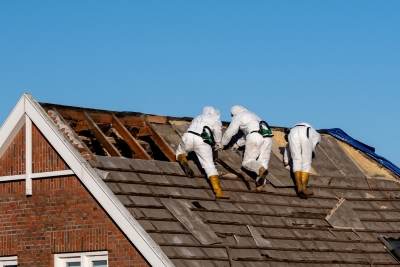Asbestos in Roof Shingles
Asbestos was a popular construction material because of its durability and heat resistance. Asbestos roofing shingles were widely used in homes throughout much of the 20th century, up until the 1980s, when the dangers of asbestos became well-known.
Today, asbestos shingles can still be found in older buildings. Roofers and construction workers face higher risks of asbestos exposure while working with these materials. Over time, exposure can lead to serious illnesses like mesothelioma, a rare cancer that affects the lining of the lungs, abdomen or heart.
Many companies knowingly exposed workers to asbestos even after knowing the risks. If you or a loved one developed mesothelioma after being exposed to asbestos in roofing shingles, you may have the right to seek compensation. You should consult with a legal professional to explore your options and get the support you deserve.
History of Asbestos in Roofing Shingles

Roofing shingles containing asbestos were highly valued for their ability to withstand heat and harsh weather conditions. They were a reliable option for protecting homes and buildings and preventing fires from consuming them so quickly.
Use of asbestos in shingles peaked between the 1940s and 1970s. During this time, asbestos was also used in other materials like insulation, cement, floor tiles and siding. However, research emerged showing that inhaling asbestos fibers can lead to serious diseases like asbestosis, lung cancer and mesothelioma. Regulations were introduced to limit asbestos use in most construction materials by the 1980s.
Finally, in March 2024, the U.S. Environmental Protection Agency (EPA) announced a ban on chrysotile asbestos. Today, while asbestos is no longer used in shingles and other building products, older homes and buildings may still contain the hazardous material.
Types of Asbestos Shingles
Asbestos roof shingles were commonly made from asphalt, cement or transite. Asphalt shingles with asbestos were the most widespread, while asbestos-cement shingles offered extra strength.
1. Asphalt Shingles
Asphalt shingles are one of the most common roofing materials used in residential homes. Manufacturers added asbestos fibers to a mix of asphalt and materials like felt, which also often contained asbestos, to improve fire resistance and strength. Asphalt shingles containing asbestos were very popular from the 1940s through the 1980s because they were durable, affordable and easy to install. Eventually, asbestos was phased out in favor of modern asphalt shingles, which often use fiberglass or an extra laminate layer to add durability.
2. Cement Shingles
Cement shingles with asbestos added were another popular roofing material from the early to mid-20th century. Made by mixing asbestos in cement, these shingles were durable, weather-resistant and fireproof. They were often used in harsh climates or buildings that needed extra protection. By the late 1970s and early 1980s, asbestos-cement shingles were discontinued and replaced with composite or synthetic roofing.
3. Transite Panels
Transite roofing panels were made from a blend of asbestos and cement, similar to cement shingles but in larger, sheet-like forms. They were less common in residential homes and were mostly used in commercial, industrial and agricultural buildings because they were resistant to chemicals and heat. Because the panels are so large, they are more likely to become damaged, broken or worn down and release asbestos fibers into the air. Modern transite panels no longer contain asbestos, but older panels can still pose hazards.
Asbestos in Other Roofing Materials
In addition to shingles, asbestos was present in other roofing materials. Roofing products with asbestos included:
- Corrugated roofing sheets: These wavy, metal-reinforced sheets often contained asbestos in industrial or agricultural settings.
- Flat roofing systems: Asbestos was used in some flat roofing systems, often in waterproofing materials or coatings to prevent leaks and add durability.
- Roofing adhesives and sealants: Asbestos was mixed into adhesives, caulking, cements, mastics and sealants to strengthen them and improve heat resistance.
- Roofing felt: Felt underlayment was a paper-like material that was often made with asbestos for extra durability and fireproofing.
- Roofing tar: Asbestos roofing tar was common in construction, especially on flat or low-sloped roofs.
- Slate roofing: Slate tiles were sometimes mixed with asbestos to increase fire resistance, especially in high-risk fire zones.

A complete guide delivered next day to your doorstep. Treatment Information, top doctors & cancer centers, financial assistance and more.
How Are People Exposed to Asbestos in Shingles?
People are exposed to asbestos in shingles when the materials are disturbed, causing asbestos fibers to become airborne. This often happens during activities like roofing repairs and demolition. Weather events, fire and water damage can also cause asbestos shingles on a roof to become friable, which means they are easily broken down. Once airborne, these tiny fibers may be inhaled and settle in the lungs, where they can cause serious health problems that take decades to appear.
Roofers, construction workers and demolition crews who handle asbestos-containing materials regularly can be exposed to asbestos on the job. They risk inhaling fibers while cutting, sanding or removing shingles without protection. Over time, this repeated exposure can lead to asbestos-related diseases.
Before there were strict health protocols, workers could also unknowingly carry asbestos fibers home on their clothes or tools and expose family members. Secondary exposure has been linked to cases of mesothelioma in those who never directly handled asbestos. An experienced mesothelioma attorney can help you determine how you or your loved one was exposed.
Occupations At-Risk
Roofers weren’t the only workers at risk of asbestos exposure from shingles. Many occupations connected to roofing could be exposed, especially if the person is working with older buildings or materials. At-risk occupations include:
- Carpenters
- Construction workers
- Demolition workers
- Firefighters
- Handymen
- Home inspectors
- HVAC installers
- Insulation workers
- Maintenance workers
- Painters
- Roofers
- Sheet metal workers
Manufacturers of Asbestos Roof Shingles
Many asbestos companies manufactured products that they knew were hazardous and knowingly exposed workers to health risks. Many were subject to lawsuits and created asbestos trust funds to compensate victims. Here are some of the companies linked to asbestos shingles:
- Atlantic Asphalt Corporation
- Barrett Roofing
- CertainTeed Corporation
- Eternit Corporation
- Flintkote Company
- GAF Corporation
- Johns Manville
- Keasbey and Mattison Company
- National Gypsum Company
- Raymark Industries
- Reynolds Metals Corporation
- Slate and Sheathing Company
Compensation for Mesothelioma Victims
If you or a loved one has been diagnosed with mesothelioma, you have a few different compensation options available. An experienced attorney can help you identify the best option and navigate the legal process.
- Lawsuits: You may be able to file a lawsuit against the manufacturers of the asbestos shingles that led to your mesothelioma. Mesothelioma settlements can cover medical costs, lost income and pain and suffering.
- Asbestos trust funds: Some companies filed for bankruptcy rather than face lawsuits. They established asbestos trust funds to compensate victims. An attorney can help you determine if the company responsible for your exposure has a trust fund and file a claim.
- Workers’ compensation: If you were exposed to asbestos on the job, you might be able to get workers’ compensation to cover medical bills and lost wages. Laws vary by state, so speak with an attorney to see if you’re eligible.
- Veterans’ benefits: Veterans exposed to asbestos during their military service may qualify for benefits from the VA (Veterans Administration). An attorney can help you apply.
FAQs
What are the risks associated with asbestos in shingles?
Asbestos in shingles poses significant health risks if it’s disturbed, releasing microscopic fibers into the air. When inhaled, asbestos fibers can lodge in the lungs, leading to serious conditions like mesothelioma, lung cancer and asbestosis, which may not develop for decades. Roofers, construction workers and demolition workers face the highest risks.
What are the possible exposure sources to asbestos in roofing shingles?
Exposure to asbestos shingles on a roof typically occurs during repair or removal. Activities like cutting, sanding or demolishing asbestos shingles can release fibers into the air. Wind, water and fire damage can also cause them to become friable and break down more easily. Anyone working with asbestos materials should follow proper safety protocols.
Is asbestos still used in the manufacturing of roofing materials?
No, asbestos is no longer used in manufacturing roofing materials. Asbestos was widely used until the 1980s, but once the health risks became widely known, it was banned in most construction products. Older homes and buildings may still contain asbestos shingles and can expose workers or homeowners during repairs or renovations.
How can homeowners determine if their shingles contain asbestos?
It’s difficult to tell if there’s asbestos in shingles by sight alone. Asbestos was so widely used in construction materials that if the shingles were installed before the 1980s, it’s likely that they contain asbestos. To be sure, homeowners should hire a licensed asbestos inspector or testing service. They’ll take samples, analyze them for asbestos and safely take care of removal.
Request a Free Case Evaluation
Request a free case evaluation now if you or someone you love has been diagnosed with mesothelioma. The evaluation will cost you nothing. Our lawyers will travel to visit you at your convenience or conference call with you over the phone. We understand how difficult a time this is for you and will assist in any way that we can. You can also call us toll-free at 1-800-336-0086 at any time.




